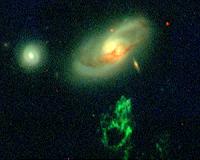 |
Paris, France (ESA) Apr 29, 2011 ESA's fleet of space telescopes has captured the nearby Andromeda Galaxy, also known as M31, in different wavelengths. Most of these wavelengths are invisible to the eye and each shows a different aspect of the galaxy's nature. Visible light, as seen by optical ground-based telescopes and our eyes, reveals the various stars that shine in the Andromeda Galaxy, yet it is just one small part of the full spectrum of electromagnetic radiation. There are many different wavelengths that are invisible to us but which are revealed by ESA's orbiting telescopes. Starting at the long wavelength end, the Planck spacecraft collects microwaves. These show up particles of incredibly cold dust, at just a few tens of degrees above absolute zero. Slightly higher temperature dust is revealed by the shorter, infrared wavelengths observed by the Herschel space telescope. This dust traces locations in the spiral arms of the Andromeda Galaxy where new stars are being born today. The XMM-Newton telescope detects wavelengths shorter than visible light, collecting ultraviolet and X-rays. These show older stars, many nearing the end of their lives and others that have already exploded, sending shockwaves rolling through space. By monitoring the core of Andromeda since 2002, XMM-Newton has revealed many variable stars, some of which have undergone large stellar detonations known as novae. Ultraviolet wavelengths also display the light from extremely massive stars. These are young stars that will not live long. They exhaust their nuclear fuel and explode as supernovae typically within a few tens of millions of years after they are born. The ultraviolet light is usually absorbed by dust and re-emitted as infrared, so the areas where ultraviolet light is seen directly correspond to relatively clear, dust-free parts of Andromeda. By putting all of these observations together, and seeing Andromeda in its many different colours, astronomers are able to follow the life cycle of the stars.
Share This Article With Planet Earth
Related Links Planck Astronomy News from Skynightly.com
 Citizen Scientists Making Incredible Discoveries
Citizen Scientists Making Incredible DiscoveriesHuntsville AL (SPX) Apr 26, 2011 "Somewhere, something incredible is waiting to be known," wrote Carl Sagan. And now you can be the one to find it, thanks to Zooniverse, a unique citizen science website. Zooniverse volunteers, who call themselves "Zooites," are working on a project called Galaxy Zoo, classifying distant galaxies imaged by NASA's Hubble Space Telescope.1 "Not only are people better than computers at detect ... read more |
|
| The content herein, unless otherwise known to be public domain, are Copyright 1995-2010 - SpaceDaily. AFP and UPI Wire Stories are copyright Agence France-Presse and United Press International. ESA Portal Reports are copyright European Space Agency. All NASA sourced material is public domain. Additional copyrights may apply in whole or part to other bona fide parties. Advertising does not imply endorsement,agreement or approval of any opinions, statements or information provided by SpaceDaily on any Web page published or hosted by SpaceDaily. Privacy Statement |